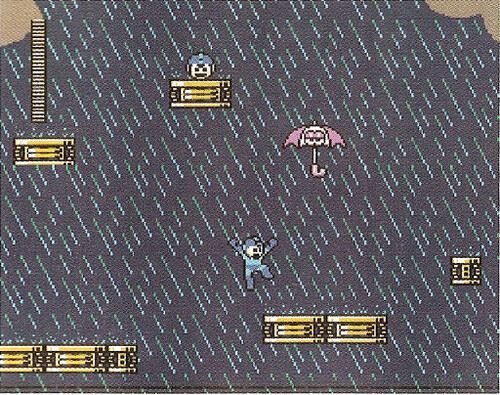The relentless march of technological progress burdens game developers by forcing teams to repeatedly spend time and energy learning the idiosyncrasies of the latest gear rather than sharpen their skills on a single toolset. As a result, few gaming platforms are explored to the depth that other creative technologies have enjoyed. Compare the number of DJs still playing vinyl records on Technics-1200 turntables to the population developing new SNES titles.

Screenshot from Mega Man 2 on the NES.
Keiji Inafune, the Capcom character designer responsible for Mega Man, recently remarked about this constraint:
"[The simple fun of a classic Mega Man game] doesn't fit into the grandiose and expansive world that the consumer gaming industry has become, and so you have to make games that match the current expectations."
The unnamed force here is the cash factor. Consumers paying top dollar for the latest-gen console expect to be dazzled. Developing a title that could have come from that grey box in the closet is incredibly risky. Fortunately, the growth of digital distribution is sufficiently shifting the financial balance to permit long tail niche development to seep into gaming. (Though Geoffrey makes a good point in complicating notions of "niche" in his earlier entry on the subject.)
The latest issue of Nintendo Power reveals that the next installment in the Mega Man series will be a "new NES game" complete with chiptune soundtrack and faithful 8bit graphics.

Screenshot from Mega Man 9 on the Wii (as printed in Nintendo Power).
According to the article, the popularity of retrographics on t-shirts and other nostalgic bric-a-brac convinced Capcom that it was the "right time" to revive the original Mega Man aesthetic.
This announcement is an encouraging sign that the unfortunate neglect of past platforms by the mainstream gaming industry is beginning to ebb. Free from the need to create playable demos of the latest hardware, studios can nurture a unique language and approach to game design and development.
Innovation along many axes will finally break the brutal linearity characterizing many of the last decade's popular titles (Doom begat Half-Life begat Halo 3...). The beauty of Flash-based titles like Dino Run is an early indication of the potential in joining a persistent platform to yesterday's aesthetics.
In its pursuit of "the upper-limits of 8-bit", I suspect Inafune's team will be surprised to discover a ceiling of considerable height. Let's hope they inspire others to similarly explore past aesthetics, constraints, and joys.







One interesting thing about an "NES" game on the Wii is whether the platform's constraints will truly be the same. An NES could only handle a certain number of sprites on the screen, etc. Is this game going to be truly an NES game, as in running on an NES emulator, or is it going to be, say, developed in Flash to look 8-bit?
This may seem pedantic, but again, one major reason that early Mega Man games never reached the "bullet hell" states of later ones is that the NES simply couldn't render more than a few bullets at a time. It all comes down to technology delivering actual gameplay limitations, not just the aesthetic ones we can slap on a T-shirt.
It appears that, while not actually using an emulator, the team has made sprite glitches an option that players can turn on and off. Given that, I would imagine that they would also have tried to make the game playable with all the glitches.
They've certainly tried to self-impose the limitations of 8-bit technology to constrain and guide their art style. As for slapping old-school art on T-shirts, they've apparently taken it one step further than most would expect.